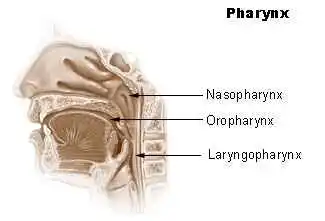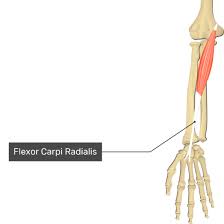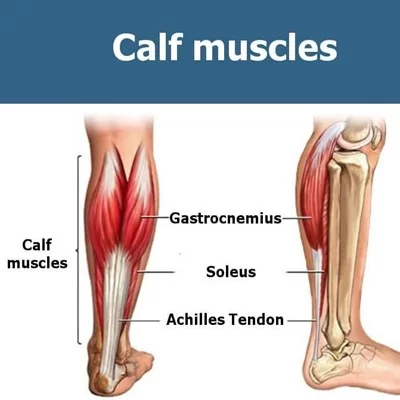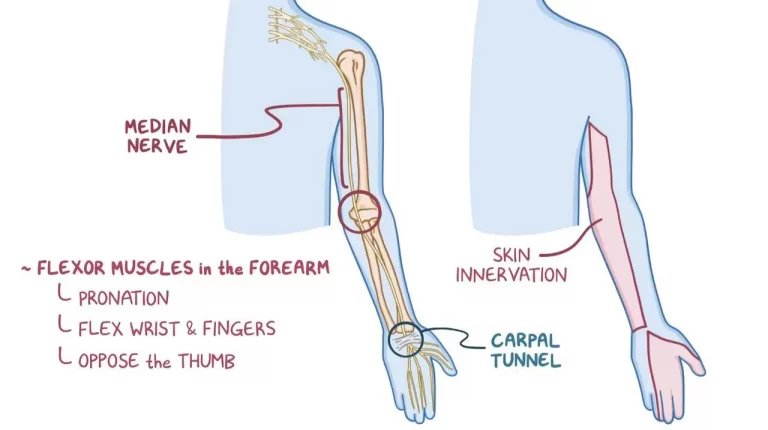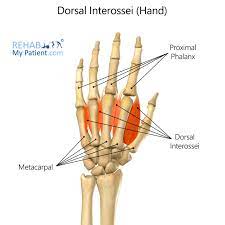Pharynx
Table of Contents
Definition
The pharynx is a muscular tube that plays an important role in the respiratory and digestive systems. Located behind the nasal and oral cavities and extending to the larynx and esophagus, it serves as a pathway for the passage of air to the lungs and food to the stomach.
Structurally, the pharynx is divided into three regions: the nasopharynx, oropharynx, and laryngopharynx, each with specialized functions that help protect the respiratory tract and aid in swallowing. Its complex anatomy and interaction with surrounding structures make the pharynx essential for basic functions like breathing, swallowing, and vocalization.
Overview
The pharynx region is utilized for respiration and stomach emptying. Thick muscle and connective tissue fibers join the pharynx to the base of the head and the structures around it. The horizontal and cylindrical muscles form the way for the esophageal walls. The circular muscles help drive food down the esophagus and stop air from being ingested, while the longitudinal fibers raise the pharyngeal walls when swallowing.
Anatomy
The pharynx is classified into three sections corresponding to its proximal interaction:
- Nasopharynx – The region located on the upper side of the mouth and throat is called the nasopharynx. It combines your nose as well as the respiratory system.
- Oropharynx – The cavity known as the oropharynx can be found in the upper part of your throat. It joins your oral cavity and contains your tonsils in the base of your tongue. The opening for liquids, foods, and air is your oropharynx.
- Laryngopharynx- The hypopharynx is a phrase applied to indicate the best part of the nasal cavity. It controls the movement of air into your lungs and the absorption of food via your esophagus towards your digestive tract.
Function
You should be conscious of the pharynx’s activities if you have been listening carefully. The pharynx’s tubular form makes its primary purpose—facilitating the flow of air, solids, and liquids from the mouth and nose—quite apparent. The muscles enhance peristaltic contraction (constrictors) and swallowing as well as speaking (longitudinal muscles).
Test your newly acquired awareness of the pharynx by passing the following personalized quiz. It includes all the necessary information, comprising arteries, veins, and muscles (attachments and functions), all of which have been organized at random to assist you with the most difficult pharyngeal anatomy task.
Muscles of pharynx
The superior, middle, and inferior constrictors—known by the acronyms stylopharyngeus, salpingopharyngeus, and palatopharyngeus, in particular—are the pharyngeal muscles. The constrictor muscles on one or both sides extend from the jaw, hyoid, larynx, and head.
They are connected above to the pharyngeal tubercle on the basilar region of the occipital bone and interact with the oesophageal wall below as they sweep through the pharynx and examine the median raphe, which resides across the pharynx’s posterior border.
Arteries
The pharynx has an extensive amount of artery anastomoses, creating a highly supplied blood anatomical structure. Its blood supply is received by four major arteries, all of having branches off of the external carotid artery:
- Ascending pharyngeal artery
- facial artery (especially important for the jaw and tonsillar branches)
- Lingual artery
- Maxillary artery
They could originate near the chest or supply the pharynx with both up and down pharyngeal arteries. Other arteries that have a significant connection with the pharynx but do not necessarily supply it with new blood constitute an addition to these.
The exterior palatine vein distributes blood to that region and passes via the pharyngeal plexus. In consequence, the latter originates in the inner carotid pulse. For more information concerning all the blood veins that supply the pharynx, observe the animation that accompanies it.
Nerves
The significant structural component that activates the throat is the pharyngeal nerve plexus. Three important cranial nerves are its origins:
- Vagus nerve (CN X)
- Glossopharyngeal nerve (CN IX)
- Maxillary nerve (CN V2)
Through a case in point of the stylopharyngeus, all of the pharynx’s muscles and structures get motor innervation from the pharyngeal branches of the vagus nerve. The latter acquires electrical impulses from the glossopharyngeal nerve.
On top of that, the tongue and throat nerve’s pharyngeal ramifications provide auditory signals to the great majority of the pharynx. Therefore, the nasopharynx’s sides and upper parts are connected by the maxillary nerve. The inferior aspect of the laryngopharynx, which protects the larynx’s origin, is supplied with sensation by the internal branch of the vagus nerve. Learn all there is to learn about the pharyngeal nerves by observing the video underneath.
Conditions and Disorders
Your throat can be impacted by any aspect from ordinary cold to throat cancer. Probably the most typical conditions are:
- Sore throat (pharyngitis) is caused by tonsillitis, infections, allergies, or mouth breathing.
- Infections include viral diseases like flu and mononucleosis alongside bacterial infections involving strep throat.
- Cancer includes carcinomas of the throat, which are hypopharyngeal, the oral cavity, and nasopharyngeal.
- Stroke, multiple sclerosis (MS), or other medical conditions that affect your central nervous system and cause dysphagia, which is difficulty swallowing.
Symptoms of conditions that affect the pharynx
Numerous disorders could affect your pharynx, which causes many kinds of symptoms. There are more serious conditions than others. In this case, a sore throat does not always indicate throat cancer. However, if your symptoms prolong or occur again, you should consult a medical professional.
- An aching throat that lasts for a long time.
- Troubling swallowing
- Earache.
- Fever is more than 39 degrees Celsius (103 degrees Fahrenheit), which could indicate an illness.
- Lumps in the back of your neck.
- Your neck feels weak or stiff.
Common tests of the pharynx
Medical professionals can conduct several tests, such as:
- Biopsy.
- Laryngoscopy.
- Throat culture.
- Testing methods embrace computed emission tomography (CT) scans and MR imaging (MRI).
FAQs
What is the significance of the pharynx?
The tract that passes from the base of the skull to the level of the sixth cervical vertebra is known as the pharynx or throat. it serves as a pathway for the passage of air to the lungs and food to the stomach.
What is the pharynx’s blood supply?
The laryngopharynx senses blood through its dominant thyroid artery, descending thyroid artery, and ascending pharynx artery. The ascending pharyngeal artery starts medially off of the following and flows through the internal and external coronary arteries (ECA) as it rises to over the pharynx.
What other name does the pharynx know from?
In the center of your neck is your throat, or pharynx. Your laryngopharynx, oropharynx, and nasopharynx have been included (inset).
The pharynx is supplied by which nerve?
The pharyngeal plexus, which is formed of branches of the facial nerves IX and X, contributes sensory as well as motor control to the pharynx. Through its pharyngeal branches, cranial nerve X acts as the primary motor nerve for the pharynx muscles.
References
- Professional, C. C. M. (2024b, May 1). Pharynx (Throat). Cleveland Clinic. https://my.clevelandclinic.org/health/body/21869-pharynx
- Pharynx. (2024, September 29). In Wikipedia. https://en.wikipedia.org/wiki/Pharynx
- Joshi, A. S., MD. (n.d.). Pharynx Anatomy: Overview, Gross Anatomy, Microscopic Anatomy. https://emedicine.medscape.com/article/1949347-overview
- The Editors of Encyclopaedia Britannica. (1999, May 27). Pharynx | Definition, Location, Function, Structure, & Facts. Encyclopedia Britannica. https://www.britannica.com/science/pharynx

